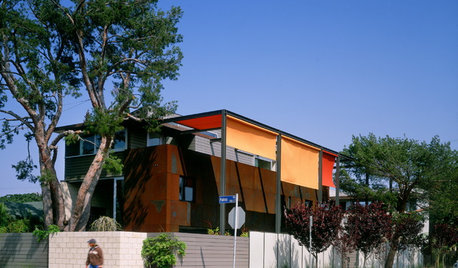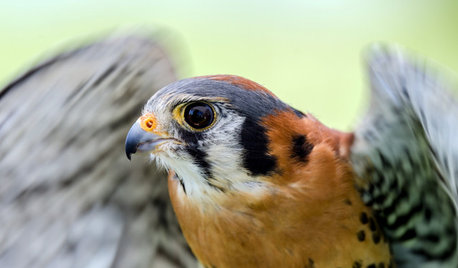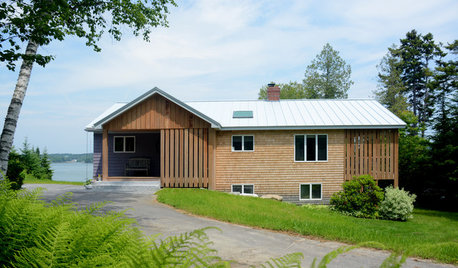cedar rust and copper
On the advice of a local nursery, I sprayed my crabapple trees with a fungicide containing copper. I just read an online article that claimed copper is weak for CAR. This is the third year of CAR and the first time I've sprayed. I've had my Prairie Fire and Sugar Thyme -- both purportedly resistant to CAR -- for four years. Not long after I sprayed, the Prairie Fire began defoliating rapidly, and the Sugar Thyme -- the younger tree -- is beginning to lose leaves, too. I have found relatively few CAR-infected leaves, and I suspect the cedar host has been eliminated. Could the copper be causing this defoliation? I have been removing the dropped leaves, and I fertilized.
Comments (21)
jellyman
15 years agoJayne:
In my opinion, it is clearly the copper that is causing the defoliation, although it would be helpful to know the chemical analysis on the fungicide label, particularly the form of the copper and its strength. I use copper (in the form of copper hydroxide) as a dormant spray on both pome and stone fruits, but do not use it during the growing season because of past experience with leaf damage. However, dormant sprays do not protect against CAR, since new infections can blow in each spring if the host cedars remain and conditions are right.
CAR is an early-season phenomenon, and arrests itself as the weather warms and dries out. But the damage is already done if the fungus has infected your apples and leaves. CAR can spot the leaves heavily, but does not normally result in much defoliation.
There are several fungicides said to be effective against CAR when used with the right timing, which is very early. The only one I have been able to purchase is Ferbam, which will do the job if applied at bud break and again at petal fall. Fungicides act as a preventative during this period, which is when the fungus becomes established.
I also discovered some time ago that disease "resistant" apple varieties are not disease immune, especially when weather conditions are favorable to the spread of diseases like CAR and fireblight.
Fertilization, BTW, will not help your problem, and is a waste of time and money at this stage of the season. If you get too much nitrogen on apples, it can contribute to later rapid, leafy growth the following season that may make the trees even more susceptible to diseases. Your trees will probably survive their bout with copper, but I wouldn't try that again during the growing season.
Don Yellman, Great Falls, VA
virginiald
15 years agoI asked the owners of a commercial orchard near Charlottesville VA what they used on CAR and they said they use Captan. Any thoughts on this? I thought this was one of the really toxic chemicals but they said that it did not persist.
Virginia in Virginia
Related Professionals
Folsom Landscape Architects & Landscape Designers · Signal Hill Landscape Architects & Landscape Designers · Wilmington Landscape Contractors · Allentown Landscape Contractors · College Park Landscape Contractors · Del Aire Landscape Contractors · Fort Atkinson Landscape Contractors · Louisville Landscape Contractors · North Lauderdale Landscape Contractors · Salem Landscape Contractors · Vineyard Landscape Contractors · Palos Hills Landscape Contractors · Lauderdale Lakes Landscape Contractors · North Aurora Landscape Contractors · Norridge Landscape Contractorsjayne_vt
Original Author15 years agoThanks for your input, Don. I used Bonide Copper in basic copper sulphate, which the nursery worker told me to apply AFTER petal fall and when the leaves are well established. Do you think, if I had sprayed earlier, that defoliation would have been avoided? I was told by another local "expert" to keep the leaves cleaned up under the trees -- with many plantings beneath them, this is a real pain! -- and to fertilize with 10-10, because the trees were obviously under stress. Here, in northern Vermont, we've had MUCH rain this summer; how, if at all, does that impact the situation?
Are Ferbam and Captan -- thanks Virginia -- available to the home grower? Also, Don, what the heck is BTW? Thanks much.
Jayne, Burlington, VT
glenn_russell
15 years agoHi Jayne-
I too have been struggling with CAR for the last couple years. If you do a search on these forums, you'll see my complaints about Bonide's Fruit Tree Spray saying it works on CAR, even though its main ingredient Captan does not. To back that statement up, follow the link at the bottom of this posting, and look at the table on page 3-3. YouÂll see that, according to that table, Captan is ineffective against CAR. So, I too am confused why a commercial orchard would recommend this. I've sprayed Captan every 7-10 days as recommended by the Bonide label, and I didn't see it make any difference in the CAR.Yes, Captan is easily obtainable. No, Ferbam is not available to home growers. If you really want the Ferbam, you may want to use the detective work that I did: http://forums2.gardenweb.com/forums/load/fruit/msg0611131118252.html Lucky for me, I didnÂt have to go that route, and I was able to obtain it through a friend.
I agree with Don, even supposedly disease resistant trees can get CAR. My 2 Liberty trees do indeed have CAR this year but it isnÂt too bad.
My plan for next year is to do some experimenting. First, IÂll be doing the dormant/early copper spraying that Don recommends. If CAR was my only problem, then that might be all IÂd try for a couple of my trees. (My reasoning is that if the Captan has been doing almost nothing for CAR, perhaps a dormant copper spray would be all IÂd need. but, since scab, etc. is also a problemÂ) Next, most of my 7 trees will get the Ferbam treatment But, IÂm going to try Immunox (not as easy to find as Captan, but you can at least find it on the web, and it is rated for fruit trees. Link for that below too) on a couple of them to see if it works as well as the Ferbam. (DonÂt confuse "Immunox" with "Immunox Plus" which also contains an insecticide and is not rated for fruit trees) If I can simply spray the Immunox twice, the same way as people do with Ferbam, and it is just as effective, then it might be a nice, easier-to-obtain way of dealing with CAR. Once my experiment is done, IÂll post my results.
Good luck in your quest!
-Glenn
HereÂs where I got the Immunox: http://www.amazon.com/Spectrum-61000-16-Multi-Purpose-Fungicide/dp/B000HAAOD6/ref=pd_bbs_sr_2?ie=UTF8&s=home-garden&qid=1216947533&sr=8-2
Here is a link that might be useful: Effectiveness of Fungicides for Control of Tree Fruit Diseases
jayne_vt
Original Author15 years agoThank you Don and Glenn. Glenn, your post about CAR was the first one I read before I joined up, so I knew I had come to the right place to get help.
BTW, my neighbor is a horticulturist and works for a large, local inn. She oversees all gardens and plantings there. She told me that, at the inn, they have the crabapple trees injected each year. She said it costs around $65 a tree. Ever heard of that?
I thought the offending cedar host may have been put out of commission, but I was wrong. Bad news is, it's just 3 houses away. Good news is, the house is up for sale. So, I can only hope the next owner removes the eyesore or that a righteous bolt of lightning strikes it dead.
I hope that next spring I'll finally be poised to battle this problem once and for all! Thank you all, again, for your invaluable information.
Jayne Burlington, VT
virginiald
15 years agoGreat info in "Effectiveness of Fungicides for Control of Tree Fruit Diseases", although extremely depressing reading. Makes me itch and check my toes for orange fungal blooms. Particularly interesting that Captan is not rated for CAR. Perhaps it's the old joke about keeping elephants away by sticking cloves of garlic in your ears. If you do it, and see no elephants, then clearly the garlic worked. Or then again, perhaps there were no elephants in the vicinity.
Jayne, if the house is up for sale, now is your opportunity to go out with a chainsaw at dead of night.
All kidding aside, I have personally got the message that early spraying with SOMETHING is essential in the presence of CAR. Next winter I'll start looking around for Immunox and Ferbam, instead of the copper that I sprayed far too late this spring (yes, me too, Jayne!).
Virginia in Virginia
glenn_russell
15 years agoHi Jayne & Virginiald-
I still consider myself a newbie to fruit trees and battling CAR, so IÂm not positive IÂm the right place Even though I might not know the answer, I can at least share my experience and where IÂm heading. I enjoy talking about it because I hope I can (and usually do) learn more myself.
Interesting about the crabapple injections. Was it specifically for CAR or something else? Would she be able to provide any more specifics?
As for the neighborÂs cedar, are you positive it is the source of your CAR? Only certain varieties of cedar are hosts for the disease. For example, I have 35 Blue-Rug (creeping) junipers next to my apple trees. They are not compatible with CAR, thus, no galls, no problem. Although I donÂt know the exact number, sources (on this forum, websites) have said that CAR can spread 1-5 miles from the juniper to the apple tree. So, perhaps your neighborÂs cedar isnÂt the problem after all? If it does have an orange gall, then use a hand saw. ItÂs quieter. : - )
Actually, for me, this yearÂs CAR wasnÂt quit as bad as last year. My Red Delicious tree (and the same variety on my 5-1) was hit hardest as usual, which is weird because many sites say this is actually a resistant variety. If I counted the yellow-orange spots, IÂd say it has 5x as many as my Granny Smith, Liberty, Williams Pride, Enterprise, Courtland, Macintosh, Summerland, Yellow SemiTransparent, etc.
Glad the "Effectiveness of Fungicides for Control of Tree Fruit Diseases" link was useful. IÂve used it a lot.
As for Immunox, other posters have said that you would indeed want to limit it to one or two sprays, otherwise you could develop resistance to it. Good luck in the Ferbam quest!
-Glenn
glenn_russell
15 years agoOne oddity that I've noticed is that table shows a '-' for copper's efficacy on CAR, but others like Don, etc. are quite confident in copper's efficacy. Is the "Copper Bordeaux" different than the dormant copper we're planning on spraying or the copper in the Kocide? Or, perhaps they are saying Copper mid-season isnÂt effective? Any thoughts? -Glenn
jellyman
15 years agoGlenn:
I am not at all confident in CAR control from copper, although I do dormant spray the apple trees with Kocide, which is copper hydroxide. I think this is helpful against overwintering apple scab. Bordeaux mixture contains copper sulphate and slaked lime, and I do not use it on fruit trees, although I believe it is useful on grapes.
Cedar apple rust is a much more formidable foe than scab, since you can eliminate it in your own orchard, including cleanup of all leaf debris, and it will still blow in anew early in spring, given the right weather conditions. Where I live, those weather conditions occur more often than not in springtime.
That is why I use Ferbam against CAR, although I do not by any means insist it is the only solution. It's just the only one I have found. I have lost over 80% of apple crops to CAR, and that was on the apples themselves, not just the leaves.
Don Yellman, Great Falls, VA
glenn_russell
15 years agoThanks for the clarification Don. Wow, 80%... that must have been frustrating. Looking forward to trying out my Ferbam (and Immunox) next year. -Glenn
jayne_vt
Original Author15 years agoHi, all!
Well, I hope my trees survive the copper, so that I might get an earlier start next year with an appropriate product. BTW, (love that)underneath Copper on the Bonide cannister is (Bordeaux Modern Replacement) Spray or Dust. It claims to "Control disease on potatoes, tomatoes, fruits, flowering shrubs and shade trees. The instructions do not mention flowering crabs. For apples, it counteracts antracnose, bitter rot, black rot, blotch, and powdery mildew. So, I was somewhat loathe to use it in the first place, but I assumed the folks at the nursery knew what the hey they were talking about.
I will certainly get more information from my neighbor regarding the injections.
As to the cedar host...another neighbor pointed it out to me last spring, and yes indeedy, it had the gelatinous tendrils. I checked it out yesterday and saw 1 woody gall. I suppose I could saw it down little by little (it's right under a street light). Or, I could gird it; I don't know how long it would take to effectively strangle the culprit.
I'll get back to you on the injections. Ciao!Jayne Burlington, VT
jellyman
15 years agoJayne:
If you have a portable electric drill and are willing to do a little night work, you can make that Juniperis Virginia very sick, maybe unto death. Girdling a tree is pretty obvious.
Buy some strong brush killer, the undiluted stuff, not the spray bottles, and about a 3/8" bit for your drill. Under cover of darkness, drill a series of holes around the tree right at the soil line and downward into the root zone about 6 inches apart. Pour about half a quart of the pure brush killer around the perimeter of the tree so it runs into the holes. Ruffle the dead needles around the base to cover your work. Reserve the other 1/2 quart for a second attempt if the first is not successful.
You should begin to see results in a month or so. And you did not hear this from me.
Don Yellman, Great Falls, VA
jayne_vt
Original Author15 years agoHey, mum's the word! 'Bout how many inches apart should those holes be?
I think I figured out why the second nursery worker recommended the leaf clean-up. I think I have SCAB, too! Some leaves turn yellow, then orange or red before they drop. But, many have dark (purplish) spots, which I assumed was part of the defoliation process. So, I have three issues....JEEZUM CROW (VT's state bird)! After you mentioned, Glenn, that keeping the leaves cleaned up wasn't going to effect CAR one way or the other, I relaxed. Now, it's back to the broom - takes a lot of effort, but with gas prices... So, is it important to keep them cleaned up, or is the goal to have them off the ground before snow falls? Thanks, in advance, for your continuing help...I sure do appreciate it!Jayne Burlington, VT
glenn_russell
15 years agoJayne-
Yep, we have to keep our diseases separate!
Captain is indeed used scab (but not CAR). But, both Ferbam and Immunox are good for both, and with the Ferbam, you only have to spray twice, where as the captain you have to spray every 7-10 days (I believe). WeÂll see how my Immunox testing goes next year.
Actually, it was Don who talked about keeping the leaves cleaned up. Regardless of CAR, you still need to clean up the fallen apple leaves to help reduce the scab problem.
Good luck!
-Glennvirginiald
15 years agoFollowing on what you just said, Glenn (and Don), can the fallen apple leaves be composted or will that just perpetuate the scab? What about rusted apples? Do those need to go in the trash?
Virginia in Virginia
glenn_russell
15 years agoFrom what I've read, you really want to burn or remove them from the property. Scab "Spores will linger on infected material, surviving the winter very easily, ready to re-infect the tree in spring."
Truth be told, until I put in my new front yard orchard next year, some of my trees are in an area (half in the woods, but still get good sun) where I can't really clean out the old leaves. But, the Captain has seemed to overcome the scab. As for the rusted apples, I would think if the rusted leaves werenÂt a problem, then the rusted apples wouldn't be either. But, from what I've read, a ground free of dead leaves and bad apples is really the goal for a healthy orchard.
-GlennHere is a link that might be useful: Apple & pear scab
Michael
15 years agoJayne:
My non-CAR resistant Jonafree was hammered with CAR last year; the resistant one, Freedom, had some symptoms. This year, begining early as Don suggested, I used a spray program employing Immunox and Cleary's 3336. So far, the jonafree has only a few affected leaves and the Freedom has none. Environmental conditions were excellent for infection this year and there are literally hundreds if not thousands of cedars within 2 miles of our rural home.
I suspect the sprays worked.glenn_russell
15 years agoHi Michael-
How many times did you spray the Immunox? If you only sprayed the Immunox twice, did you do it at petal fall and another a week to 10 days later like Don does with the Ferbam? And how many times for the 3336? What were you using the 3336 to fight? PM (to help out the Immunox), Scab (to help out the Immunox), sooty blotch, fly speck? This is the first time I've seen someone talk about using 3336. How did you do against the other diseases? Anything else you sprayed? Sorry for all the questions, and thanks in advance! -GlennMichael
15 years agoWell lets see, my spray schedule THIS year went like this according to my records: Kocide 2000 @ just prior to pre-bud swell @ 9 lb rate + dormant oil. Since I could not find and procure Immunox until full bloom, that's when it first was applied. I should have started prior to tight cluster. Five days later was the next Immunox app.. This was done in only 5 days as a "catch up" according to some university recommendations that I can't site currently. Being a group 3 fungicide with resistance problems, I wanted to use it early and the 3336 later if needed. Also, 3336 is a group 1 fungicide, resistance development will be lessened using it following the Immunox. Idealy it is best to mix a protectant fungicide with the Immunox (it's a systemic) according to literature that I've read.
Fourteen days later, started with a 3336 + captan mix on all trees.
Seven days later, applied Mancozeb to my non-bearing trees as we had alot of rain with more forecasted. Mancozeb has a 77 day harvest interval and is cheaper and supposedly effective for scab.
My other tree has good resistance to CAR and scab so it was left out.Seven days later, as several trees had a little bit of scab, and because I was concerned about it spreading (more rain forecasted) I sprayed one more round of the 3336 + captan mix.
Then the rains finally stopped and so did my spraying. Maybe that was smart, maybe not. I have no summer disease problems YET, and the CAR and scab are non-existant.
Immunox is for the scab and CAR where I am and the 3336 is for CAR and summer diseases (black rot, flyspeck, etc.).
I haven't had any PM problems at all ever. Maybe next year!
My basic approach as far as fungicide selection goes is 1) use a systemic mixed with a protectant especially up thru 1st cover and then evaluate from there. 2) avoid resistance by both tank mixing a protectant and systemic of different groups, and not using the Immunox more than 2 sprays in a row and no more than 3 times in a season. If you do that you'll quickly find that your options are very limited. 3) hopefully, decrease rates and/or intervals as environmental and disease conditions permit. 4) Learn as much as possible as soon as possible and be very, very observant. 5) Keep good records. Mine last year were horrible, but then, I didn't do much and it showed. This year was far better, time will tell if it shows, so far all is well.
glenn_russell
15 years agoHi Michael-
Thank you very much for all the info!!!
I may look towards procuring the Kocide 2000 and 3336 in the future. My spraying plan for next year is much more advanced than this year, but time will tell if it works. At any rate, it should be better than this year.
Because I've got the Ferbam, most of my trees will get it, others will get the Immunox, and a one will get both (in that case, itÂs because that tree needs PM protection which Ferbam doesnÂt have). When IÂm using the Ferbam, IÂm hoping it will prevent the sooty blotch and fly speck in the bags. But, with my Immunox experiment, I may need to spray the 3336 on those to prevent SB & FS. I'm hoping I can avoid the Mancozeb and Captain sprays.
Ideally, IÂd spray some sort of dormant spray, and then two legal, easy-to-obtain fungicides. Kocide and Ferbam fits the bill, except I canÂt recommend Ferbam to others because itÂs so hard to obtain, etc. IÂm also worried putting too much Kocide copper in my soil, so I may just stick with simple dormant oil for now. IÂm also interested in experimenting with what I can recommend to others: IÂm hoping dormant oil, 2 Immunox sprays, and a 3336 sprays or two would also do a good job.
IÂll take careful notes and adjust what I need for the following season. Too bad it takes years for the experimenting!
-Glenn


















jellyman